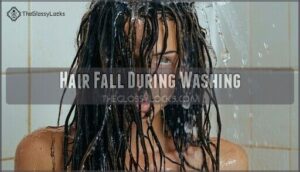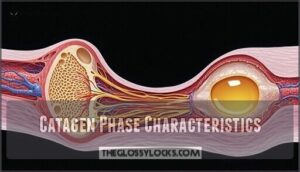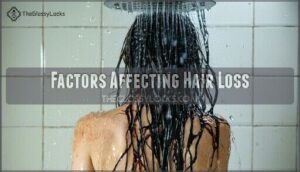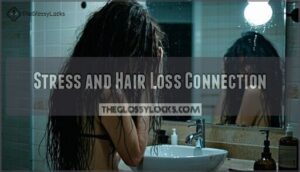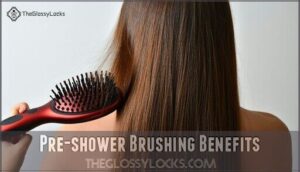This site is supported by our readers. We may earn a commission, at no cost to you, if you purchase through links.
 When you wash your hair, it’s normal to see some strands falling out.
When you wash your hair, it’s normal to see some strands falling out.
Your scalp naturally sheds about 50-100 hairs daily as part of the hair growth cycle.
Washing your hair often loosens strands that were already in the shedding phase (called the telogen phase), which can make it seem like you’re losing more hair than usual.
Factors like scalp stimulation during washing, the time since your last wash, and even your hair’s texture can affect how much you notice.
Don’t panic—this is usually harmless.
However, if the shedding feels excessive, it might be time to check in with a dermatologist.
Table Of Contents
- Key Takeaways
- Hair Fall During Washing
- Why Hair Falls Out When Washing
- Hair Growth Cycle Explained
- Factors Affecting Hair Loss
- Stress and Hair Loss Connection
- Reducing Hair Shedding Techniques
- Showering Practices and Hair Health
- When to Seek Medical Advice
- Frequently Asked Questions (FAQs)
- How can I stop my hair from falling out when I wash it?
- Is it normal to lose a lot of hair when washing it?
- Is it normal for hair to fall out when I run my fingers through it?
- Why is my hair falling out while I shower?
- Can certain hairstyles contribute to shower hair loss?
- Does the water quality affect hair shedding?
- How does hormonal imbalance influence hair fall during washing?
- Is there a genetic predisposition to losing more hair in the shower?
- Can hair loss indicate a specific health issue?
- Does water quality affect hair shedding during washing?
- Conclusion
Key Takeaways
- Washing your hair dislodges strands already in the shedding phase, which is part of your natural hair growth cycle and usually harmless.
- Factors like harsh scrubbing, hot water, and skipping washes can worsen shedding or make it seem more noticeable.
- Stress, hormonal imbalances, and scalp health issues can push more hair into the shedding phase, making hair loss more visible during washing.
- Using gentle shampoos, lukewarm water, and a soft touch can minimize shedding and keep your hair healthier.
Hair Fall During Washing
When you wash your hair, it’s normal to notice strands coming loose because washing helps dislodge hairs already in the shedding phase.
Washing your hair gently frees loose strands in their natural shedding phase—embrace it as part of your scalp’s spring-cleaning routine!
Everyone loses up to 100 hairs daily, so seeing some fall out in the shower isn’t usually a cause for concern.
Normal Hair Shedding Process
Shedding vs. Loss: It’s normal to see hair fall out when washing.
Daily hair count varies, but losing 50-100 strands daily is typical.
Hair shedding results from growth phases—old strands make way for new ones.
Seasonal shedding and individual variation can increase this.
Don’t stress; this routine process isn’t permanent loss, it’s just your scalp’s spring-cleaning!
Hair Growth Cycle Stages
Hair moves through three growth cycle phases.
The anagen phase, lasting years, drives active growth (around 85-90% of your hair).
The catagen phase, triggered briefly, shifts follicles.
Finally, the telogen phase impacts 10-15% of hair, resting before shedding naturally.
This cycle interplay maintains follicle health, but disruptions can alter the telogen percentage, leading to noticeable hair shedding, which affects the overall hair shedding process.
Average Daily Hair Loss
Spotting hair strands in the shower might feel alarming, but losing 50-100 hairs daily is normal.
Everyone’s normal hair count varies due to shedding variation factors like thickness or season.
Seasonal hair loss can bump up the number slightly. If you’re washing hair less often, accumulated hair shedding may appear excessive, but it’s just older strands catching up with seasonal hair loss.
Why Hair Falls Out When Washing
When you wash your hair, it’s normal to notice some strands slipping away. Don’t panic—this isn’t a sign of immediate hair loss.
Wet Hair Fragility makes your strands more prone to breakage. Shampoo Ingredient Impact can amplify this if harsh chemicals are involved.
Your scalp gets a workout while you lather, helping to dislodge hairs already in the shedding phase. That’s why Shower Hair Accumulation feels dramatic—it’s just hair that would’ve fallen out gradually.
Scalp Oil Buildup can also weaken hair roots, contributing to easier hair shedding. A buildup of oil can even lead to clogged hair follicles.
However, Washing Technique Effects matter too: scrubbing too hard might lead to excessive shedding or breakage. Stick to gentle handling—your hair will thank you for the TLC!
Hair Growth Cycle Explained
Your hair goes through a natural growth cycle with phases of growth, rest, and shedding.
When you wash it, you’re often noticing hairs that are already in the shedding phase, which is completely normal.
Anagen Phase Details
The anagen phase is the superstar of hair growth, where follicles engage in active growth.
This phase lasts years, fueled by rapid cell division and a steady nutrient supply.
Healthy follicles thrive here, producing strong strands.
Over 85% of your hair is in this phase, but washing won’t disrupt it.
Instead, gentle care supports follicle health and minimizes unnecessary hair shedding.
Catagen Phase Characteristics
After new strands grow in the anagen phase, follicles enter the catagen phase—the brief “transition stage.”
In this stage, degenerative growth halts, melanocyte activity drops, and strands undergo follicle shrinkage before detaching.
It’s nature’s way of letting go without panicking.
-
Key aspects of the catagen phase:
- Degenerative growth stops
- Follicle shrinkage occurs
- Reduced melanocytes affect pigmentation
- Cell death concludes growth
- Lasts around 2-3 weeks
Telogen Phase Impact
Around 10-15% of your hair is in the telogen phase at any time, where it rests before naturally shedding.
Washing your hair often dislodges these strands, making it feel like you’re losing more.
The shedding duration varies by person, but healthy follicle recovery guarantees a growth phase shift follows.
However, cycle disruptions, like telogen effluvium, can increase noticeable hair loss.
| Telogen Phase Facts | Normal Range | Impact |
|---|---|---|
| Hair in Telogen Phase | 10-15% | Natural, prepares for shedding |
| Daily Shedding | 50-100 strands | Includes telogen hairs dislodged during washing |
| Shedding Duration | 3-6 months | Hair rests before new growth begins |
| Follicle Recovery Importance | High | Guarantees continuous hair regrowth |
| Cycle Disruption Effects | Increased Hair Loss | Stress, health issues, or telogen effluvium |
Factors Affecting Hair Loss
Your hair type, how often you wash it, and even the way you massage your scalp all play a role in how much hair you lose in the shower.
Understanding these factors can help you spot what’s normal and when it’s time to make a change.
Hair Type and Thickness Impact
Your hair type and thickness play a big role in how much hair you lose when washing.
Thick or long hair sheds more due to higher overall density, while fine or coily hair may break easily when wet.
It’s normal to notice increased shedding if you’ve skipped washes—those strands were just waiting their turn, which can be a normal experience, especially when considering the density of your hair.
Scalp Stimulation Effects
A little scalp stimulation while washing hair can do more than just promote scalp health—it’s like a mini workout for your follicles.
Here’s how:
- Massage Benefits: Gently massaging boosts circulation, encouraging follicle activation.
- Exfoliation Effects: Removes buildup, helping product absorption.
- Circulation Boost: Improves nutrient delivery to follicles.
- Hair Shedding: Stimulates loose hairs in the telogen phase to shed naturally, which can be considered a form of follicle activation and overall scalp health.
Time Since Last Wash
If you’ve skipped a few washes, don’t panic when more hair sheds in the shower.
Longer gaps between washing allow oily buildup and product accumulation, impacting scalp health. This can loosen shed hairs and even lead to temporary hair breakage.
Washing frequency matters—keeping hair cleanliness balanced helps manage normal hair loss while avoiding excess hair shedding or buildup issues.
| Factor | Influence on Hair |
|---|---|
| Longer gaps | More noticeable shedding |
| Oily buildup | Blocks hair follicles |
| Product accumulation | Impacts scalp health |
| Frequent washing | Prevents buildup, reduces shedding |
| Balanced cleanliness | Improves hair health overall |
Stress and Hair Loss Connection
When stress takes over, your body reacts in ways you mightn’t expect, including triggering hair loss.
This happens because stress pushes more hair follicles into the resting phase, leading to noticeable shedding.
Telogen Effluvium Causes
Telogen effluvium happens when stress triggers like hormonal imbalance, nutritional deficiencies, medication effects, and underlying illnesses push more hairs into the telogen phase.
This temporary condition causes noticeable hair shedding, often mistaken for alarming hair loss.
One common cause is a change in the number of hair follicles, leading to increased hair shedding.
Hair fall causes linked to stress disrupt your hair growth cycle, but don’t worry—managing these issues often brings shedding back to normal quickly.
Physical and Emotional Stress
Ever wonder why stress wreaks havoc on your hair?
Stress hormones from emotional trauma or physical strain push more strands into the shedding telogen phase, a condition called telogen effluvium.
Sudden lifestyle changes, chronic illness, or intense worry can trigger noticeable hair loss.
While stress hair loss isn’t permanent, the shock to your system can make shower hair shedding more obvious, leading to a condition that can be described as telogen effluvium.
Managing Stress for Hair Health
Managing stress is key to healthier hair.
Stress reduction through mindfulness practices or deep breathing can relax scalp tension and boost blood flow.
A healthy diet rich in vitamins, combined with good sleep quality, helps hair recover.
Stress hair loss isn’t fixed overnight—be patient.
Remember, chronic stress increases hair shedding, so controlling stress can minimize hair loss causes, and stress reduction can lead to healthier hair.
Reducing Hair Shedding Techniques
If you’re tired of seeing clumps of hair in the shower, a few simple changes can make a big difference.
From brushing before washing to using conditioner and avoiding hot water, these techniques help reduce shedding and keep your hair healthier.
Gentle Hair Care Practices
To reduce hair shedding, adopt a gentle hair care routine.
Use lukewarm rinsing to protect shine and avoid scalp irritation. Massage your scalp gently to boost circulation, and stick to gentle products suitable for your hair type.
Towel-dry with care, patting instead of rubbing to prevent hair breakage. Wet detangling with a wide-tooth comb and silk scrunchies minimizes damage further.
Consider incorporating sulfate-free shampoos for a milder cleanse, and overall, aim for a routine that promotes hair health.
Pre-shower Brushing Benefits
Brushing before washing offers multiple perks.
It detangles knots, preventing matting and breakage.
With scalp stimulation, it boosts circulation, promoting healthy roots.
Pre-shower brushing also loosens shedding hairs, reducing clumps later.
Plus, it helps distribute natural oils evenly, prepping strands for cleaning.
Many people find a specialized brush works best for this.
Think of it as a head start against hair loss and unnecessary shower stress!
Using Conditioner and Avoiding Hot Water
Using conditioner after washing hair protects damaged hair by locking in moisture and improving elasticity.
Choose products with nourishing ingredients for scalp health and to minimize hair loss.
Stick to lukewarm water—hot water weakens strands, worsening hair shedding.
Gently apply conditioner to avoid breakage, especially when hair is wet and fragile.
Some users seek specialized shedding conditioners to address this issue.
Consistent care reduces shedding while maintaining healthier hair and improving hair elasticity by using nourishing ingredients and minimizing hair loss.
Showering Practices and Hair Health
How you shower plays a big role in your hair’s health, even if you don’t realize it.
Using hot water, harsh products, or handling wet hair roughly can lead to unnecessary damage and shedding.
Impact of Shower Frequency
Showering too often or too seldom can impact hair shedding.
Frequent washing might strip natural oils, making hair brittle, while rare washing lets product buildup and scalp oiliness block follicles.
Your hair type matters—fine hair may need more frequent washing than thick hair.
Finding the right washing frequency helps minimize shower-related hair loss without triggering unnecessary strand shedding, which is crucial for maintaining healthy hair and preventing hair loss and scalp oiliness.
Hot Water and Product Choice
Hot water can be harsh on your scalp, stripping natural oils and increasing hair shedding.
It lifts the hair cuticle, leaving strands dry and brittle.
Pair this with harsh shampoo ingredients, and you might face scalp irritation or chemical damage.
Opt for lukewarm water, gentle hair products, and moisture-rich conditioner ingredients to protect your hair from unnecessary breakage.
Many people are switching to gentle shampoos and conditioners to prevent hair damage.
Gentle Handling of Wet Hair
Wet hair elasticity makes strands fragile and prone to snapping.
Handle your hair gently after washing to prevent breakage.
Skip rough towel drying—pat it with a soft cloth instead.
Fine hair care benefits from wide-tooth combs or hair brushing only when dry.
Use lukewarm water, gentle products, and light touches to minimize shower hair loss and hair shedding effectively.
A shower comb benefits hair health by reducing damage and promoting overall hair health, which is crucial for effective hair care.
When to Seek Medical Advice
If you’re noticing larger clumps of hair falling out or if your scalp seems inflamed, it’s time to get things checked out.
A doctor can help pinpoint the cause and recommend the right treatment to keep your hair healthy.
Signs of Abnormal Hair Loss
If you’re noticing sudden hair loss, patchy bald spots, rapid thinning, or excessive shedding beyond 125 strands daily, it’s time to pay attention.
Sudden hair loss or rapid thinning? Over 125 strands daily might signal a deeper issue—time to take action for healthier tresses!
Persistent scalp inflammation or excessive breakage during shower hair loss could signal abnormal issues.
Normal hair shedding is expected, but these hair loss symptoms might point to underlying concerns needing further attention.
Importance of Professional Evaluation
Sometimes, hair shedding feels excessive, leaving you worried. Seeking professional help can clarify whether it’s normal or serious.
Experts provide personalized care to identify underlying conditions and offer effective treatment options.
- Pinpoint causes with a hair loss diagnosis.
- Explore preventative measures for future shedding.
- Rule out hidden health issues.
- Gain confidence through expert diagnosis and customized advice to address hair shedding.
Addressing Underlying Hair Loss Issues
If excessive shedding feels unmanageable, addressing possible root causes like nutritional deficiencies or telogen effluvium can restore balance.
Medical evaluation helps pinpoint factors like scalp health or hormonal shifts. Depending on results, lifestyle changes, targeted medication options, or improving your diet may curb hair fall.
Taking control early prevents worsening hair loss and guarantees healthier hair shedding patterns long-term, which can be achieved by making lifestyle changes.
Frequently Asked Questions (FAQs)
How can I stop my hair from falling out when I wash it?
On average, losing up to 100 strands daily is normal.
To minimize shedding when washing, use lukewarm water, a gentle shampoo, and avoid harsh scrubbing.
Handle wet hair delicately and condition regularly for strength.
Is it normal to lose a lot of hair when washing it?
Losing hair while washing is normal, as about 10-15% of your hair is in the resting or shedding stage.
Showering dislodges these strands, but if clumps appear, it’s worth checking for underlying issues.
Is it normal for hair to fall out when I run my fingers through it?
It’s normal to notice a few hairs when running your fingers through your hair.
These strands are likely already in their shedding phase, part of your hair’s natural growth cycle.
Don’t sweat it—completely natural!
Why is my hair falling out while I shower?
Hair falling out in the shower happens because washing dislodges strands already in the shedding phase.
Scalp massage and water stimulate follicles, which is normal, unless you’re noticing substantially more hair than usual.
Can certain hairstyles contribute to shower hair loss?
Tight hairstyles, like ponytails or buns, can strain your hair roots, making strands looser and more prone to shedding during washing.
Give your scalp a break with relaxed styles to reduce hair loss.
Does the water quality affect hair shedding?
Hard water, packed with minerals like calcium and magnesium, can weaken your hair over time.
It makes strands dry, brittle, and more prone to breakage.
Using filtered or soft water helps reduce shedding and damage.
How does hormonal imbalance influence hair fall during washing?
Hormone imbalances, like a mischievous prankster, can disrupt your hair’s growth cycle, pushing more strands into the telogen (shedding) phase.
During washing, this imbalance causes extra shedding, revealing what’s already hanging by a thread, due to the hormone imbalances.
Is there a genetic predisposition to losing more hair in the shower?
Your genes can influence how much hair you lose in the shower.
If your family has a history of thinning hair or shedding, you’re more likely to notice extra strands falling during washing.
Can hair loss indicate a specific health issue?
Hair loss can signal underlying health issues like nutrient deficiencies, hormonal imbalances, thyroid problems, or stress.
If it’s excessive or persistent, consult a doctor to rule out conditions affecting your hair’s growth cycle.
Does water quality affect hair shedding during washing?
The minerals in hard water can weaken your hair over time, making it prone to breakage and shedding.
Soft water is gentler, keeping your strands healthier.
Filtering your water might reduce this effect, particularly by mitigating the impact of hard water.
Conclusion
They say, "Knowledge is power," and understanding why your hair falls out when you wash it can ease your worries.
Shedding during washing often just reflects your hair’s natural growth cycle, particularly the telogen phase.
Factors like wash frequency, stress, or hot water can play a role, but most shedding is harmless.
Stay gentle with your scalp, use proper products, and don’t skip self-care.
If the hair loss feels excessive, it’s best to consult a dermatologist for clarity and solutions.

